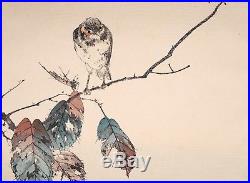
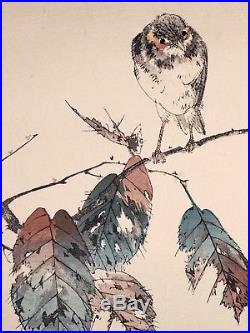

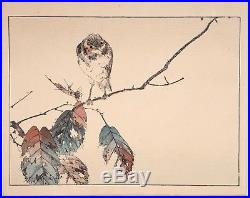
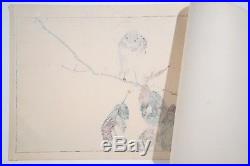
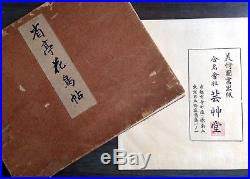
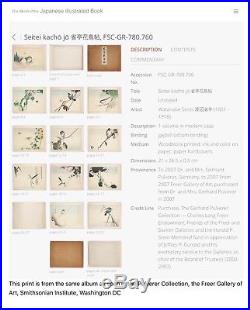
[EHON] WATANABE SEITEISEITEI KACHÔ-CHÔ. R A R E, FROM ONE OF THE MOST STUNNINGLY BEAUTIFUL JAPANESE ALBUMS OF BIRDS, INSECTS AND FLOWERS. A most superb example of the best in Japanese period polychrome woodblock printing from the late Meiji period. PRINTED ENTIRELY BY HAND FROM WOODBLOCK ON WASHI PAPER. Approximately 20 x 26 cm edge to edge. Woodcut printed in color by hand on hand-made paper. CLEAN, SOLID, IMPECCABLE IMPRINT AND TONALITY. Color fidelity of photos presented is not even close to being as soft and pure as the genuine article at hand. THIS IS AN ANTIQUE, AUTHENTIC WOODBLOCK PRINT. Just to be clear, this is 100% genuine. A genuine, authentic, woodblock print from the original blocks. Printed by the highest class printers at Unsôdô of Kyôto. Seitei died in 1918, this edition was most likely printed in 1908. This is not a reprint, a lithograph or a copy of the original of any sort. NEARLY 125 YEARS OLD, THIS FINE WORK OF ORIGINAL ART WILL BE APPRECIATED BY ALL ONCE MATTED AND FRAMED. Would also make a unique and fabulous gift for home or office! Original Japanese Woodblock Print, Meiji Era, 19th Century. Colors are very saturated and difficult to replicate with photography. No worm damage, no significant stains, no creases, no rat damage, margins and original backing included. Several facts regarding hand-made washi paper. To begin with, washi, being that it is hand-made paper, occasionally has large brown fibers or other materials entering the water and paper vats used in production, so that a grain of sand may cause a tiny hole, bump or other imperfection. This is of course not a misprint or damage and should never be looked upon as a major detraction. Lastly, Toning from age is typical. Remember, it is indicative of handmade paper that there will be varying degrees of tonality and minor blemishes with each printed leaf. As well, printmakers of that time were not obsessive about the uniformity of each individual sheet of paper. Must have been the zen. Watanabe Seiteis original name was Yoshikawa Yoshimata. He was born and lived in Tokyo and was also known as Shotei. He came from a family of rice brokers and was apprenticed to a pawn shop at the age of 12, but was fired for spending too much of his time painting. When he was 14, without his fathers permission, he became a pupil of Kikuchi Yosai (17881878), a popular and successful historical painter. At the age of 21, by which time he had started to use the go (pen name) Seitei, he was adopted by Watanabe Koshi a poet and friend of his father, also a poet. Instead of following his teacher and becoming an historical painter, Seitei became one of the best and most popular exponents of kacho ga (bird and flower paintings). His 3 books of woodblock prints Seitei Kacho Gafu, possible his most famous work, was published in 18901891; a single book Kacho Gafu in 1903 and a series of 22 prints Nijuni kacho in 1916. He wrote several books on painting and edited Bijutsu Sekai (Art World) published in 18931896. Seitei was a frequent exhibitor and prize winner in domestic and foreign exhibitions. He travelled in Europe and America. In 1878, he was awarded a silver medal for a painting shown at the Paris exposition. At a dinner with Edgar Degas they exchanged drawings but Degas ripped up his work claiming he could not match the beauty of Seiteis work. Seiteis drawing was part of Degass estate at his death. His woodblock prints are undoubtedly influenced by western watercolors which he had a chance to study on his trip to France. His style is technically brilliant; its strongest features are its fresh and lucid use of color and sensitive employment of wash, with effects reminiscent of western watercolors. The item “Rare and Authentic Seitei (Shotei) Japanese Woodblock Print SEITEI KACHÔ-CHÔ” is in sale since Sunday, November 18, 2018. This item is in the category “Antiques\Asian Antiques\Japan\Prints”. The seller is “dogstar_rising” and is located in Astoria, New York. This item can be shipped worldwide.
No comments